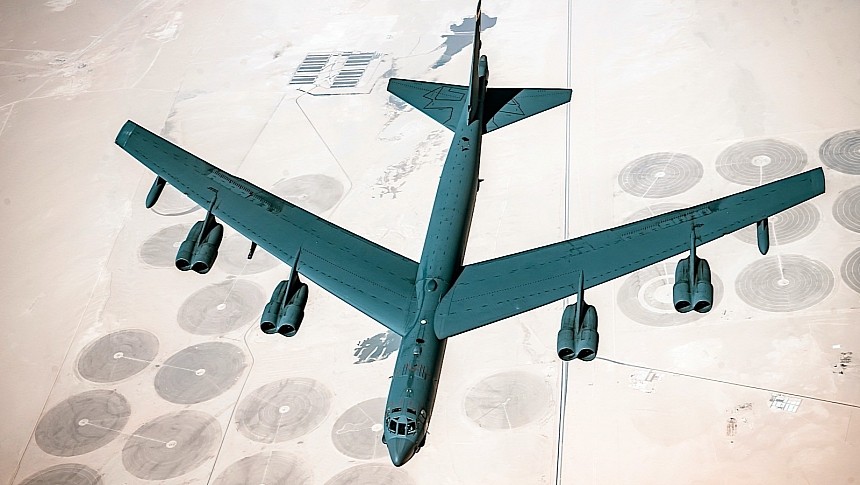By the middle of the current century, the B-52 Stratofortress will turn 100 years old. That's because the U.S. Air Force (USAF) plans to keep it operating until the mid-2050, effectively making the veteran American bomber the oldest aircraft to still be flying at that time.
Granted, the plane is nowhere near what it used to be when it was first made back in the 1950s, as constant upgrades have kept up relevant in our modern times.
But whereas upgrades have so far focused on the plane's internal components, a more important overhaul is on the horizon. They are targeting this time the very things that keep the plane running, meaning anything from its wheels and the braking system to the very engines that keep it flying.
It was back in 2021 when the USAF decided it was about time the aircraft got new powerplants, and opted for Rolls-Royce F130 units from the BR family as a replacement for the current ones.
That is the same engine family used on the C-37 special airlift missions plane, and the E-11 Battlefield Airborne Communications Node. They are capable of developing 17,000 pounds of thrust, and given how the B-52 packs no less than eight of them, that's quite the total power.
Rolls-Royce has been hard at work testing the engines all year long, and it plans to wrap up this part of the process by the end of 2023. It won't be until 2025 though that the new units will begin being installed in the Stratofortress, and replacing them for the entire fleet will take a while.
What that means is the bomber will have to fly with the current engines for some time still. Those are the TF33 of Pratt & Whitney make, and just as capable in terms of thrust levels as the future ones.
The TF33 is an engine about as old as the bomber itself, first being run in 1958. Aside from the Stratofortress, it also powers the E-3 Sentry, an airborne early warning and control aircraft that too is on the list of hardware to be replaced, with the Boeing E-7 Wedgetail scheduled to take its place in the coming years.
The TF33 will thus remain in service for a while longer, and someone has to handle their servicing. Naturally, the Defense Logistics Agency chose this week the engine's maker, Pratt & Whitney, to do that, and just handed it a $870 million contract for the task.
The money will cover the next six years of "maintenance, spare parts, program management, field service, repairs and engineering support," for a total of about 1,000 engines. The contract can be extended for an additional four years if need be, because in this business you never know what may happen, in spite of the most careful of plans.
But whereas upgrades have so far focused on the plane's internal components, a more important overhaul is on the horizon. They are targeting this time the very things that keep the plane running, meaning anything from its wheels and the braking system to the very engines that keep it flying.
It was back in 2021 when the USAF decided it was about time the aircraft got new powerplants, and opted for Rolls-Royce F130 units from the BR family as a replacement for the current ones.
That is the same engine family used on the C-37 special airlift missions plane, and the E-11 Battlefield Airborne Communications Node. They are capable of developing 17,000 pounds of thrust, and given how the B-52 packs no less than eight of them, that's quite the total power.
Rolls-Royce has been hard at work testing the engines all year long, and it plans to wrap up this part of the process by the end of 2023. It won't be until 2025 though that the new units will begin being installed in the Stratofortress, and replacing them for the entire fleet will take a while.
What that means is the bomber will have to fly with the current engines for some time still. Those are the TF33 of Pratt & Whitney make, and just as capable in terms of thrust levels as the future ones.
The TF33 is an engine about as old as the bomber itself, first being run in 1958. Aside from the Stratofortress, it also powers the E-3 Sentry, an airborne early warning and control aircraft that too is on the list of hardware to be replaced, with the Boeing E-7 Wedgetail scheduled to take its place in the coming years.
The TF33 will thus remain in service for a while longer, and someone has to handle their servicing. Naturally, the Defense Logistics Agency chose this week the engine's maker, Pratt & Whitney, to do that, and just handed it a $870 million contract for the task.
The money will cover the next six years of "maintenance, spare parts, program management, field service, repairs and engineering support," for a total of about 1,000 engines. The contract can be extended for an additional four years if need be, because in this business you never know what may happen, in spite of the most careful of plans.










